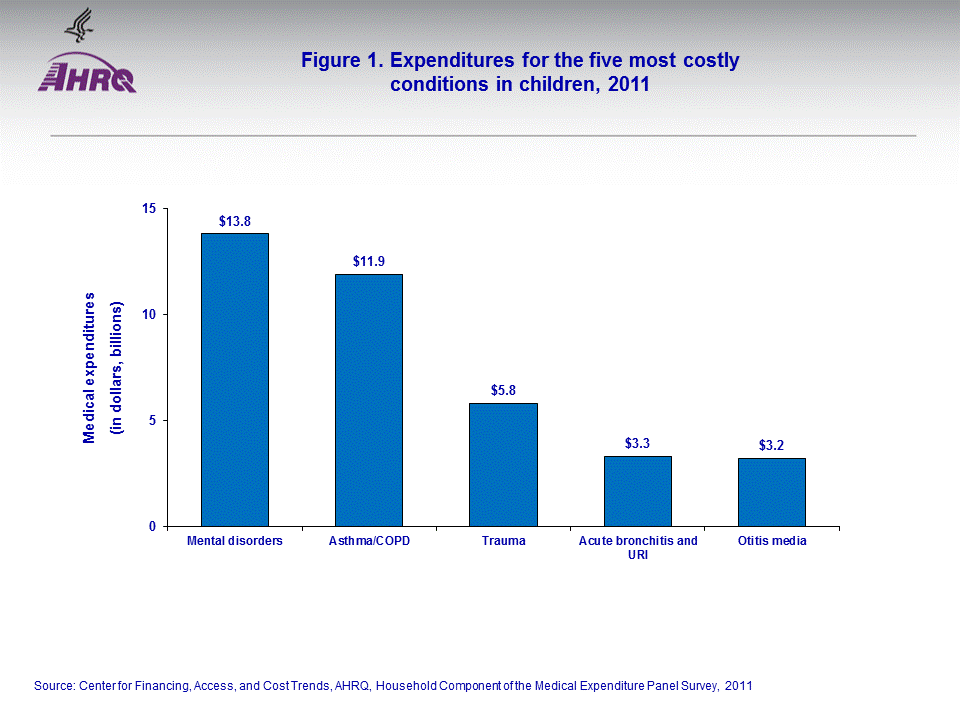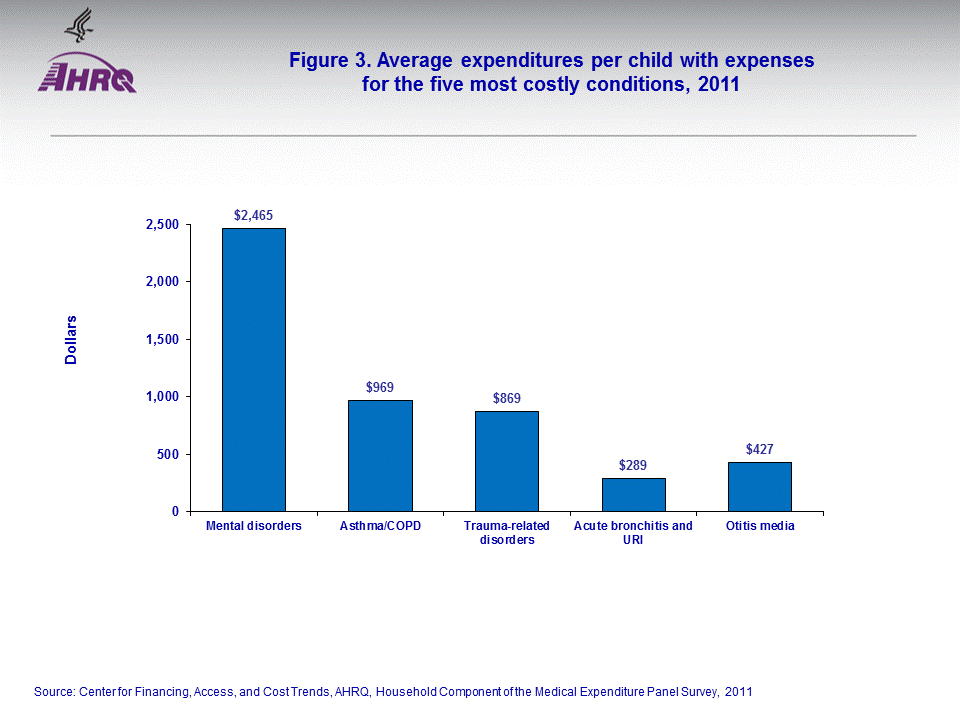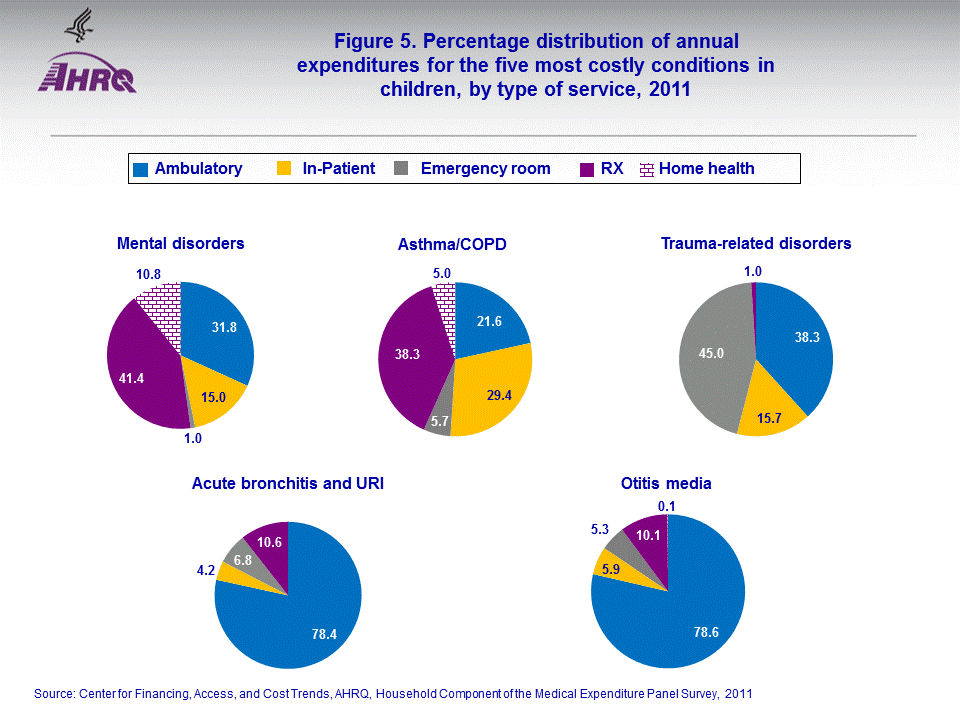
|
|
Font Size:
|
||||
|
|
|
|
||||
STATISTICAL BRIEF #434:
The Five Most Costly Children's Conditions, 2011: Estimates for U.S. Civilian Noninstitutionalized Children, Ages 0-17
Highlights
- For those under 18 years of age, these five medical conditions—mental disorders, asthma, trauma-related disorders, acute bronchitis and upper respiratory infections, and otitis media—ranked highest in terms of direct medical spending in 2011.
- Of the five most costly conditions for children, mental disorders affected the fewest children but had the highest average expense per child.
- Treatment of mental disorders ($13.8 billion) accounted for the highest total expense and acute bronchitis and URI ($3.3 billion), and otitis media ($3.2 billion) accounted for the lowest among the top five most expensive children's conditions in 2011.
- Nearly half of the expenditures for mental disorders (48.4 percent) and asthma (49.1 percent) in children were paid by Medicaid.
Introduction
This Statistical Brief presents data from the Household Component of the Medical Expenditure Panel Survey (MEPS-HC) regarding medical expenditures associated with the five most costly conditions for children ages 0–17 in 2011. These conditions (mental disorders; asthma/chronic obstructive pulmonary disease (COPD); trauma-related disorders; acute bronchitis and upper respiratory infections (URI); and otitis media (ear infections)) were determined by totaling and ranking the expenses by condition for all medical care provided in 2011. Only differences between the estimates that are statistically significant at the 0.05 level are discussed in the text.Findings
In 2011, a total of $117.6 billion was spent for the medical care and treatment of children. The top five conditions in terms of total health care expenditures were mental disorders, asthma (including chronic obstructive pulmonary disease), trauma-related disorders, acute bronchitis and upper respiratory infections, and otitis media.The highest expenditure total was for care and treatment of mental disorders in children. Total expenditures to treat mental disorders were $13.8 billion (figure 1). There were 5.6 million children who were treated for mental disorders (figure 2). Mean expenditures per child with expenses were highest for mental disorders ($2,465) (figure 3). Medicaid paid for about half of the amount spent to treat children with mental disorders (48.4 percent) (figure 4). About 41.5 percent of mental health expenditures on children were for prescription medicines (figure 5).
Expenditures for treating asthma/COPD in children totaled $11.9 billion. More than 12 million (12.3) children were treated for asthma in 2011. Mean expenditures per child with expenses for asthma were $969. Medicaid paid for about half of the expenditures incurred to treat asthma (49.1 percent) among children. Inpatient hospitalizations included 29.4 percent of asthma expenditures.
Expenses on acute bronchitis and upper respiratory infections ($3.3 billion) and otitis media ($3.2 billion) were the lowest among the five most costly conditions for children. In 2011, 11.5 million children were treated for acute bronchitis and upper respiratory infections. Acute bronchitis and upper respiratory expenditures, averaged at $289 per child with expenses, were the lowest per child mean expenditure among the five most costly conditions for children. About two-thirds (61.8 percent) of expenditures on the treatment of acute bronchitis and URI among children were paid by private insurance. More than three-fourths (78.4 percent) of expenditures on the treatment of acute bronchitis & URI were for ambulatory services.
In 2011, 7.5 million children were treated for otitis media, or ear infections. Mean expenditures per child with expenses to treat otitis media were $427. Private insurance was the predominant payer for treatment of otitis media (58.8 percent) in 2011. More than three-fourths (78.6 percent) of expenditures on treatment of otitis media were for ambulatory services.
Data Source
The estimates in this Brief were derived from the MEPS 2011 Full Year Consolidated Data File (HC-147), Medical Conditions File (HC-146), Prescribed Medicines File (HC-144A), Home Health File (HC-144H), Office-Based Medical Provider Visits File (HC-144G), Outpatient Visits File (HC-144F), Emergency Room Visits File (HC-144E) and Hospital Inpatient Stays File (HC-144D).Definitions
Medical conditions Condition data were collected from household respondents during each round as verbatim text and coded by professional coders using the International Classification of Diseases, Ninth Revision (ICD-9). ICD-9-CM condition codes were then aggregated into clinically meaningful categories that group similar conditions using the Clinical Classification System (CCS) software. Categories were collapsed when appropriate. Note that the reported ICD-9-CM condition code values were mapped to the appropriate clinical classification category prior to being collapsed to 3-digit ICD-9-CM condition codes. The result is that every record which has an ICD-9-CM diagnosis code also has a clinical classification code. For this Statistical Brief, the following CCS codes were used: infectious diseases 1–9; chronic obstructive pulmonary disease (COPD), asthma 127–134; trauma-related disorders 225–236, 239, 240, 244; acute bronchitis and URI 125, 126; and mental disorders 650–663.Expenditures Expenditures refer to what is paid for health care services. More specifically, expenditures in MEPS are defined as the sum of direct payments for care provided during the year, including out-of-pocket payments and payments by private insurance, Medicaid, Medicare, and other sources. Payments for over-the-counter drugs are not included in MEPS total expenditures. Indirect payments not related to specific medical events, such as Medicaid Disproportionate Share and Medicare Direct Medical Education subsidies, are also excluded.
Expenditures may be associated with more than one condition and are not unduplicated in the condition totals; summing over conditions would double-count some expenses. Total spending does not include amounts for other medical expenses, such as durable and nondurable supplies, medical equipment, eyeglasses, ambulance services, and dental expenses, because these items could not be linked to specific conditions.
About MEPS-HC
MEPS-HC is a nationally representative longitudinal survey that collects detailed information on health care utilization and expenditures, health insurance, and health status, as well as a wide variety of social, demographic, and economic characteristics for the U.S. civilian noninstitutionalized population. It is cosponsored by the Agency for Healthcare Research and Quality and the National Center for Health Statistics.References
For a detailed description of the MEPS-HC survey design, sample design, and methods used to minimize sources on non-sampling errors, see the following publications:Cohen, J. Design and Methods of Medical Expenditure Panel Survey Household Component. MEPS Methodology Report No. 1. AHCPR Pub. No. 97-0026. Rockville, MD: Agency for Health Care Policy and Research, 1997.
http://www.meps.ahrq.gov/mepsweb/data_files/publications/mr1/mr1.shtml
Cohen, S. Sample Design of the 1996 Medical Expenditure Panel Survey Household Component. MEPS Methodology Report No. 2. AHCPR Pub. No. 97-0027. Rockville, MD: Agency for Health Care Policy and Research, 1997. http://www.meps.ahrq.gov/mepsweb/data_files/publications/mr2/mr2.shtml
Cohen, S. Design Strategies and Innovations in the Medical Expenditure Panel Survey. Medical Care, July 2003: 41(7) Supplement: III-5–III-12.
Cohen, J. and Krauss, N. Spending and Service Use among People with the Fifteen Most Costly Medical Conditions, 1997. Health Affairs; 22(2):129—138, 2003.
2007–2010 Children's Health Care Spending Report. http://www.healthcostinstitute.org/news-and-events/press-release-childrens-health-care-spending-report-2007-2010
Suggested Citation
Soni, A. The Five Most Costly Children's Conditions, 2011: Estimates for U.S. Civilian Noninstitutionalized Children, Ages 0–17. Statistical Brief #434. April 2014. Agency for Healthcare Research and Quality, Rockville, MD. http://www.meps.ahrq.gov/mepsweb/data_files/publications/st434/stat434.shtmlAHRQ welcomes questions and comments from readers of this publication who are interested in obtaining more information about access, cost, use, financing, and quality of health care in the United States. We also invite you to tell us how you are using this Statistical Brief and other MEPS data and tools and to share suggestions on how MEPS products might be enhanced to further meet your needs. Please email us at MEPSProjectDirector@ahrq.hhs.gov or send a letter to the address below:
Steven B. Cohen, PhD, Director
Center for Financing, Access, and Cost Trends
Agency for Healthcare Research and Quality
540 Gaither Road
Rockville, MD 20850
 |
||||||||||||||||||||||||||||||||||||||||||
|
||||||||||||||||||||||||||||||||||||||||||
|
|
||||||||||||||||||||||||||||||||||||||||||
 |
||||||||||||||||||||||||||||||||||||||||||
|
||||||||||||||||||||||||||||||||||||||||||
|
|
||||||||||||||||||||||||||||||||||||||||||
 |
||||||||||||||||||||||||||||||||||||||||||
|
||||||||||||||||||||||||||||||||||||||||||
|
|
||||||||||||||||||||||||||||||||||||||||||
 |
||||||||||||||||||||||||||||||||||||||||||
|
||||||||||||||||||||||||||||||||||||||||||
|
|
||||||||||||||||||||||||||||||||||||||||||
 |
||||||||||||||||||||||||||||||||||||||||||
|
||||||||||||||||||||||||||||||||||||||||||
|
|
||||||||||||||||||||||||||||||||||||||||||


